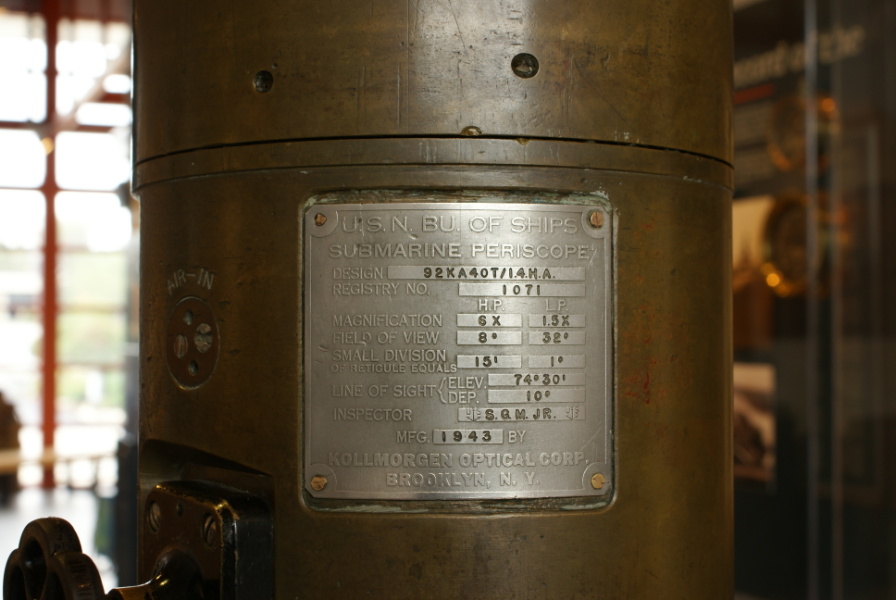| Prev |
heroicrelics.org Wisconsin Maritime Museum Site Index Periscope Gallery |
Next |
dsc75331.jpg
The identification plate on back of the periscope. It reads
U.S.N. Bu. of Ships Submarine Periscope Design 92KA40T/1.4.H.A Registry No. 1071 H.P. L.P. Magnification 6X 1.5X Field of View 8° 32° Small Division
of Reticule Equals15' 1° Line of Sight Elev. 74° 30' Dep. 10° Inspector S.G.M. Jr. Mfg. 1943 by Kollmorgen Optical Corp. Brooklyn, N.Y.
The design number breaks down as follows:
| 92 | Serial number of the periscope design |
| K | Built by Kollmorgen Optical Corp., Brooklyn, N.Y. |
| A | Type of periscope, a "bifocal altiperiscope". "Bifocal" indicates that the periscope is double power. The "altiperiscope" means that is a periscope which has the combined quality of an altiscope, a type of periscope from which the upper prism has been omitted and thus views straight upward. This means that the periscope can see from the horizon to straight above. |
| 40 | Optical length of the periscope in feet |
| T | Treated optics, which allows for increased light transmission and improved definition. |
| 1.4 | Outside diameter of the upper part of the reduced head section in inches. |
| HA | High angle, permitting view at any angle from the zenith to a point below the horizon |
Regarding the "1.4" diameter, the Submarine Periscope Manual unfortunately does not describe what the "reduced head section" is, and Google is no help, either (in fact, this page is one of the top Google result for 'periscope "reduced head section"').
However, a reader emailed me to note that many submarines during World War II had two different periscopes, an observation periscope and an attack periscope. The observation periscope had a larger head, permitting a larger field of view. The attack periscope had a smaller head so that it would be more difficult for the enemy to detect. He suggests that the "reduced head section" indicates that this is an attack periscope.
Additional research finds that the "standard attack periscope used in American naval submarines was 1-1/4 inches in diameter at the upper end" (without noting whether that is an inside or outside diameter) and refers to the "Kollmorgen attack periscope", so this does seem to be a likely explanation.

| Time picture taken | Sat Sep 25 11:19:24 2010 |
| Location picture taken |
Museum Galleries Wisconsin Maritime Museum Manitowoc, Wisconsin |
| Prev |
heroicrelics.org Wisconsin Maritime Museum Site Index Periscope Gallery |
Next |